Technology
See the world change over nearly 40 years in Google Earth’s new timelapse feature


Google Earth is zooming out to show us how the world is changing over time — a glacier retreating, a coastline eroding, or a housing development building up in the desert.
On Thursday, Google’s 3D mapping tool available on desktop or mobile app added a fourth dimension: time. With Timelapse videos you can see 24 million satellite photos from the past 37 years stitched together to show a different perspective of the world.
Some Timelapse videos include the Cape Cod coast moving southward or the Columbia Glacier in Alaska retreating over the years. Others show farms developing in Saudi Arabia or suburban sprawl taking over the Las Vegas desert.
Google Earth worked with NASA and the U.S. Geological Survey and the European Union’s Copernicus program to collect and use satellite imagery and data to form a fuller picture of Earth from 1984 through 2020. The program analyzed millions of images that would’ve taken a single computer 228 years to process, but instead took a few days.
You can access Timelapse videos for any location at g.co/Timelapse or click on the ship wheel icon in the application to see curated “tours” or stories from selected locations around the globe.
Google Earth focused its stories on forest change, urban growth, warming temperatures, mining and renewable energy sources, and the world’s fragile, changing beauty.
Google Earth has 800 Timelapse videos available for anyone to download at g.co/TimelapseVideos or to watch on YouTube.
-

 Entertainment7 days ago
Entertainment7 days agoWhat’s new to streaming this week? (Jan. 17, 2025)
-

 Entertainment6 days ago
Entertainment6 days agoExplainer: Age-verification bills for porn and social media
-

 Entertainment5 days ago
Entertainment5 days agoIf TikTok is banned in the U.S., this is what it will look like for everyone else
-

 Entertainment5 days ago
Entertainment5 days ago‘Night Call’ review: A bad day on the job makes for a superb action movie
-

 Entertainment5 days ago
Entertainment5 days agoHow ‘Grand Theft Hamlet’ evolved from lockdown escape to Shakespearean success
-

 Entertainment6 days ago
Entertainment6 days ago‘September 5’ review: a blinkered, noncommittal thriller about an Olympic hostage crisis
-

 Entertainment6 days ago
Entertainment6 days ago‘Back in Action’ review: Cameron Diaz and Jamie Foxx team up for Gen X action-comedy
-

 Entertainment6 days ago
Entertainment6 days ago‘One of Them Days’ review: Keke Palmer and SZA are friendship goals
















